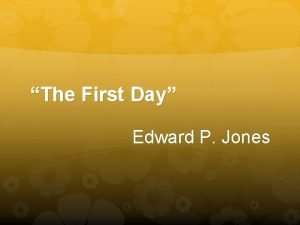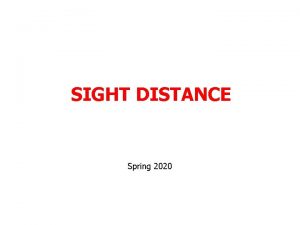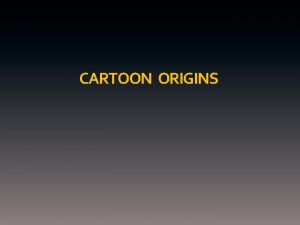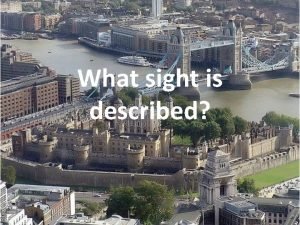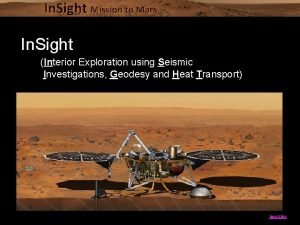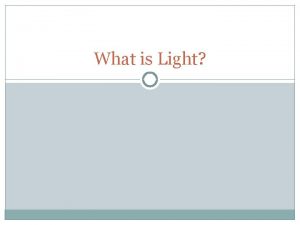Discussion of Cartoon At First Sight The cartoon








- Slides: 8

Discussion of Cartoon… At First Sight • The cartoon depicts what time period? What was going on at the time? What does the title mean? – Neolithic Revolution (10, 000 BCE to about 5000 BCE): major developments in agriculture, domestication, pottery/textiles. • Notice the first two characters in the cartoon. Who are they? – Hunter/gatherers. Migrated a lot. • What do we call people who migrate? How do they know where to go for food? – Nomads: small groups of people, made up of hunter/gatherers, which move between locations in search of food

Discussion of the Cartoon… Let’s Read It • Read the cartoon. • In the first photo, the characters seem a bit tired and when asked how things are going, they say “so-so. ” Why might they be feeling this way? – Nomadic lifestyles difficult - sometimes find nothing from hunt and location might be scarce of food. – Travel long distances. Carry all their materials – physically demanding. • What happens to these characters? What does the Neolithic man tell them? – They meet someone who tells them the Neolithic way – another way to obtain food! – He promises that if they switch to this way of life as a settler, life will be easier and happier.

Discussion of the Cartoon… Analysis • What does the Neolithic man tell them is key to the Neolithic way of life? – Domestication – people learned how to grow things where they were. No longer had to travel long distances. Could live in one place and grow enough food for year round. Impacted not only how they grew food and raised animals, but also how they lived their lives. • Read the bottom section, “Your KEYS to a BETTER LIFE. ” It says: Harness Plant Power! • Learn how the seeds you drop can become next fall’s crop! • Use seed selection to make future plants more productive and easier to harvest! • Preserve and store surpluses for hard times! • Invent new ways of preparing and cooking plant foods! Put Animals to Work for You! • Learn which species are slow and submissive! • Use food and fences to keep them around! • Influence their choice of mates! • Breed the best and eat the rest! • What do these tell you about domestication and the Neolithic way? Why might these be attractive to nomads? – Humans had more control over their environment and means of obtaining food and other resources.

Discussion of Cartoon… Analysis • What do we call people who live and produce their food in one place? – Settlers. Less migration from place to place because humans depended less on the cycles of nature. Instead, they sought a permanent home. • According to the cartoon, how does domestication work? – Neolithic man says that people learned to control animal production by selecting desirable characteristics. – They found out that by selecting specific plants and animals to harvest or breed they could yield a greater amount of food. – Agriculture actually is the modification of the environment to exploit it for more food - Artificial Selection • Notice the disclaimer at the bottom of the cartoon: “Plant and animal domestication can lead to overpopulation, deforestation, erosion, flooding, desertification, materialism, diminished nutrition, cavities, and television. Caution advised. YOUR RESULTS MAY VARY. ” What does this mean? – Side effects of agriculture.

Activity: Nomads versus Settlers • Class = two groups – Nomads – Settlers • Directions: Complete the Nomad & Settler Comparison Chart using information you have learned thus far. • Be prepared to discuss.

Discussion • Let’s go through the chart! • For those who were nomads, what was your main occupation? – Hunting and gathering. Hunters use tools, weapons to kill food. Gatherers collect food lying on the ground or in/around forest. • For those who were settlers, what was your main occupation? – Cultivating the land, planting crops, herding animals. Started digging with sticks then advanced technology across the generations (collective learning). • What might be the difference between a nomad’s and settler’s house? – Nomadic houses are easier to carry (teepees). Settlers build permanent dwellings. • What might be the ecological impact of each group? Settlers? – Would certainly impact ecology. Clear land, crop rotation, soil’s nutrients depleted, sometimes forests cut down. Biodiversity decreases. Pests and pathogens that feed on domesticated animals increase (fleas). Nomads? – All human contact affects the environment, but less than settlers. Lasting impact on environment not as great. They moved away from campsites, giving time for the land species to replenish themselves.

Activity: Travel Around the World with Plants and Animals • Food origin – All plants, animals, and humans have their own places of origin from which they began. • Foods we commonly eat, such as potatoes and corn, may not have originally come from our country. • Can you guess the origins of major foods? Keep in mind that although a culture may have adopted the use of a food in their cuisine thousands of years ago, that food may not have originated in that land.

Wrap Up • How had agriculture changed human behavior, lifestyle, the environment such as ecological impact? • What are the effects of the Neolithic period in today’s society? – Current hot topics: local foods, invasive plants/animals, land use, sedentary lifestyle – Luxury of having any type of food you desire – Very few people today grow food. Grown by large agricultural systems. • How does this relate to issues of today such as food and health, lack of physical activity, obesity, diabetes, etc. ?


